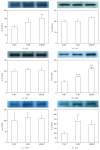Interleukin-1β accelerates the onset of stroke in stroke-prone spontaneously hypertensive rats
- PMID: 23326018
- PMCID: PMC3541647
- DOI: 10.1155/2012/701976
Interleukin-1β accelerates the onset of stroke in stroke-prone spontaneously hypertensive rats
Abstract
High blood levels of inflammatory biomarkers and immune cells in stroke lesions have been recognized as results of stroke. However, recent studies have suggested that inflammation occurs prior to stroke onset. In this study, we aimed to clarify the role of inflammation in stroke onset among stroke-prone spontaneously hypertensive rats (SHRSP). At 4 weeks of age (before stroke onset), the plasma level of IL-1β was significantly higher in SHRSP (153.0 ± 49.7 pg/ml) than in Wistar Kyoto rats (WKY) (7.7 ± 3.4 pg/ml, P < 0.001 versus SHRSP) or spontaneously hypertensive rats (SHR) (28.0 ± 9.1 pg/ml, P < 0.001 versus SHRSP) (n = 6 per strain). Stimulated IL-1β signal was also observed in cerebrovascular endothelial cells of SHRSP. Gene expressions of IL-1β, IL-1 receptors, caspase-1, and downstream genes (MCP-1 and ICAM-1), which associated with immune cell recruitment, were significantly greater in SHRSP than in WKY or SHR, coincident with greater NFκB protein levels in SHRSP compared to WKY or SHR. In addition, continuous administration of IL-1β (2 μg/day) using an osmotic pump slightly increased the incidence of stroke in SHR (P = 0.046) and significantly accelerated the onset of stroke in SHRSP (P = 0.006) compared to each control (n = 10 per group). These results suggest that a stimulated IL-1β signal might be a cause of stroke onset when concomitant with severe hypertension.
Figures




Similar articles
-
Resveratrol Partially Suppresses Inflammatory Events but Does not Affect Stroke Onset in Stroke-Prone Spontaneously Hypertensive Rats.J Atheroscler Thromb. 2015;22(9):958-70. doi: 10.5551/jat.27789. Epub 2015 Apr 7. J Atheroscler Thromb. 2015. PMID: 25854530
-
Elevated production of 20-HETE in the cerebral vasculature contributes to severity of ischemic stroke and oxidative stress in spontaneously hypertensive rats.Am J Physiol Heart Circ Physiol. 2008 Dec;295(6):H2455-65. doi: 10.1152/ajpheart.00512.2008. Epub 2008 Oct 24. Am J Physiol Heart Circ Physiol. 2008. PMID: 18952718 Free PMC article.
-
Platelet Ca2+ is not increased in stroke-prone spontaneously hypertensive rats: comparative study with spontaneously hypertensive rats.Hypertension. 1996 Jun;27(6):1312-7. doi: 10.1161/01.hyp.27.6.1312. Hypertension. 1996. PMID: 8641741
-
Pathological alterations of astrocytes in stroke-prone spontaneously hypertensive rats under ischemic conditions.Neurochem Int. 2012 Jan;60(1):91-8. doi: 10.1016/j.neuint.2011.11.002. Epub 2011 Nov 15. Neurochem Int. 2012. PMID: 22100568 Review.
-
Astrocytic nutritional dysfunction associated with hypoxia-induced neuronal vulnerability in stroke-prone spontaneously hypertensive rats.Neurochem Int. 2020 Sep;138:104786. doi: 10.1016/j.neuint.2020.104786. Epub 2020 Jun 21. Neurochem Int. 2020. PMID: 32579896 Review.
Cited by
-
Models and mechanisms of vascular dementia.Exp Neurol. 2015 Oct;272:97-108. doi: 10.1016/j.expneurol.2015.05.006. Epub 2015 May 15. Exp Neurol. 2015. PMID: 25987538 Free PMC article. Review.
-
BRG1 variant rs1122608 on chromosome 19p13.2 confers protection against stroke and regulates expression of pre-mRNA-splicing factor SFRS3.Hum Genet. 2014 May;133(5):499-508. doi: 10.1007/s00439-013-1389-x. Epub 2013 Nov 5. Hum Genet. 2014. PMID: 24190014 Free PMC article.
-
Serum Amyloid P-Component Prevents Cardiac Remodeling in Hypertensive Heart Disease.J Cardiovasc Transl Res. 2015 Dec;8(9):554-66. doi: 10.1007/s12265-015-9661-1. Epub 2015 Nov 17. J Cardiovasc Transl Res. 2015. PMID: 26577946
-
Role of the Immune System in Hypertension.Physiol Rev. 2017 Jul 1;97(3):1127-1164. doi: 10.1152/physrev.00031.2016. Physiol Rev. 2017. PMID: 28566539 Free PMC article. Review.
-
NLRP3 inflammasome activation contributes to VSMC phenotypic transformation and proliferation in hypertension.Cell Death Dis. 2017 Oct 5;8(10):e3074. doi: 10.1038/cddis.2017.470. Cell Death Dis. 2017. PMID: 28981106 Free PMC article.
References
-
- Blake GJ, Ridker PM. Inflammatory bio-markers and cardiovascular risk prediction. Journal of Internal Medicine. 2002;252(4):283–294. - PubMed
-
- Sánchez-Moreno C, Dashe JF, Scott T, Thaler D, Folstein MF, Martin A. Decreased levels of plasma Vitamin C and increased concentrations of inflammatory and oxidative stress markers after stroke. Stroke. 2004;35(1):163–168. - PubMed
-
- Madej A, Okopień B, Kowalski J, Haberka M, Herman ZS. Plasma concentrations of adhesion molecules and chemokines in patients with essential hypertension. Pharmacological Reports. 2005;57(6):878–881. - PubMed
-
- Lindsberg PJ, Grau AJ. Inflammation and infections as risk factors for ischemic stroke. Stroke. 2003;34(10):2518–2532. - PubMed
Publication types
MeSH terms
Substances
LinkOut - more resources
Full Text Sources
Medical
Miscellaneous

